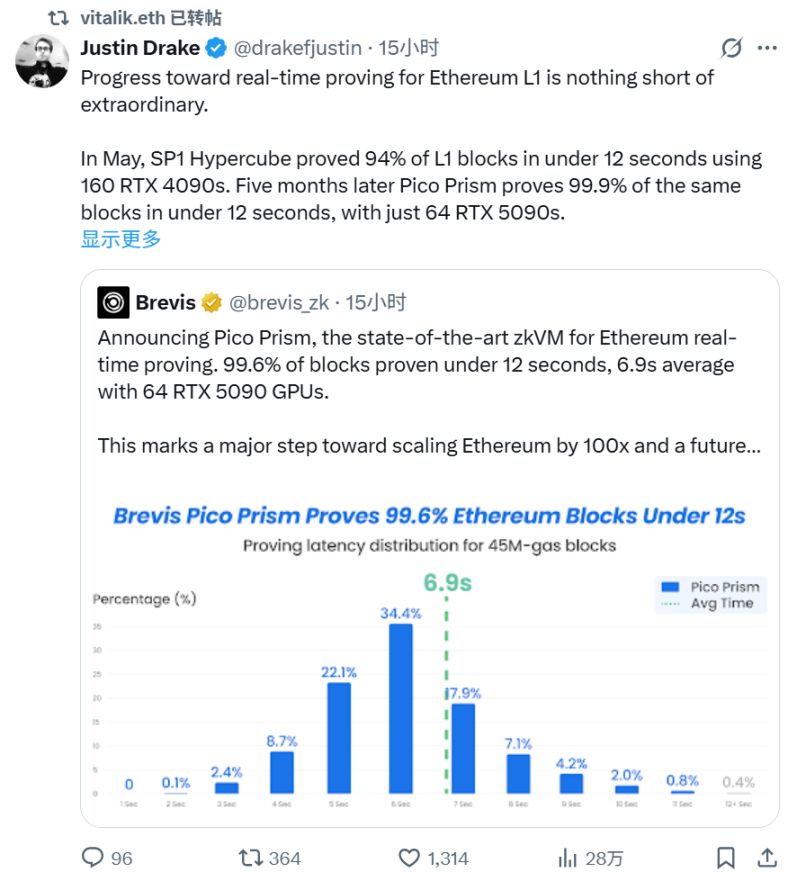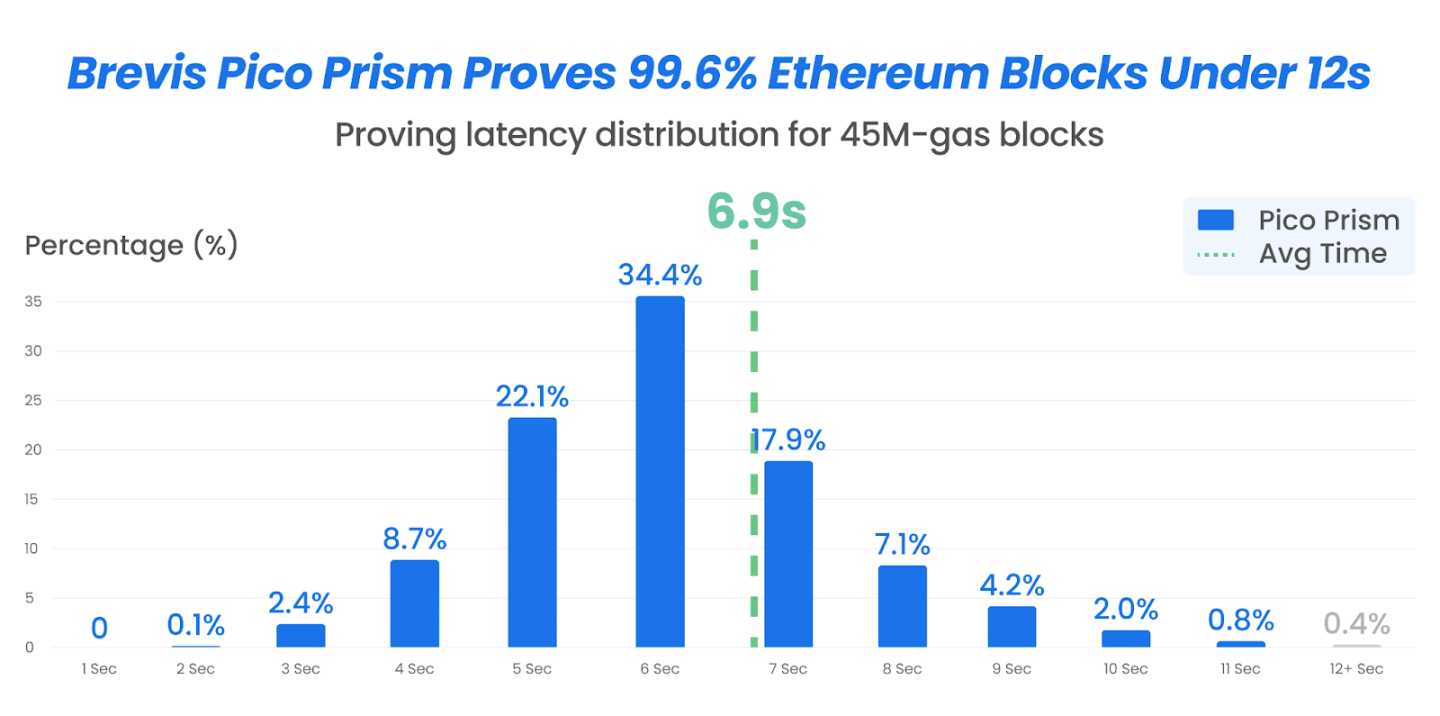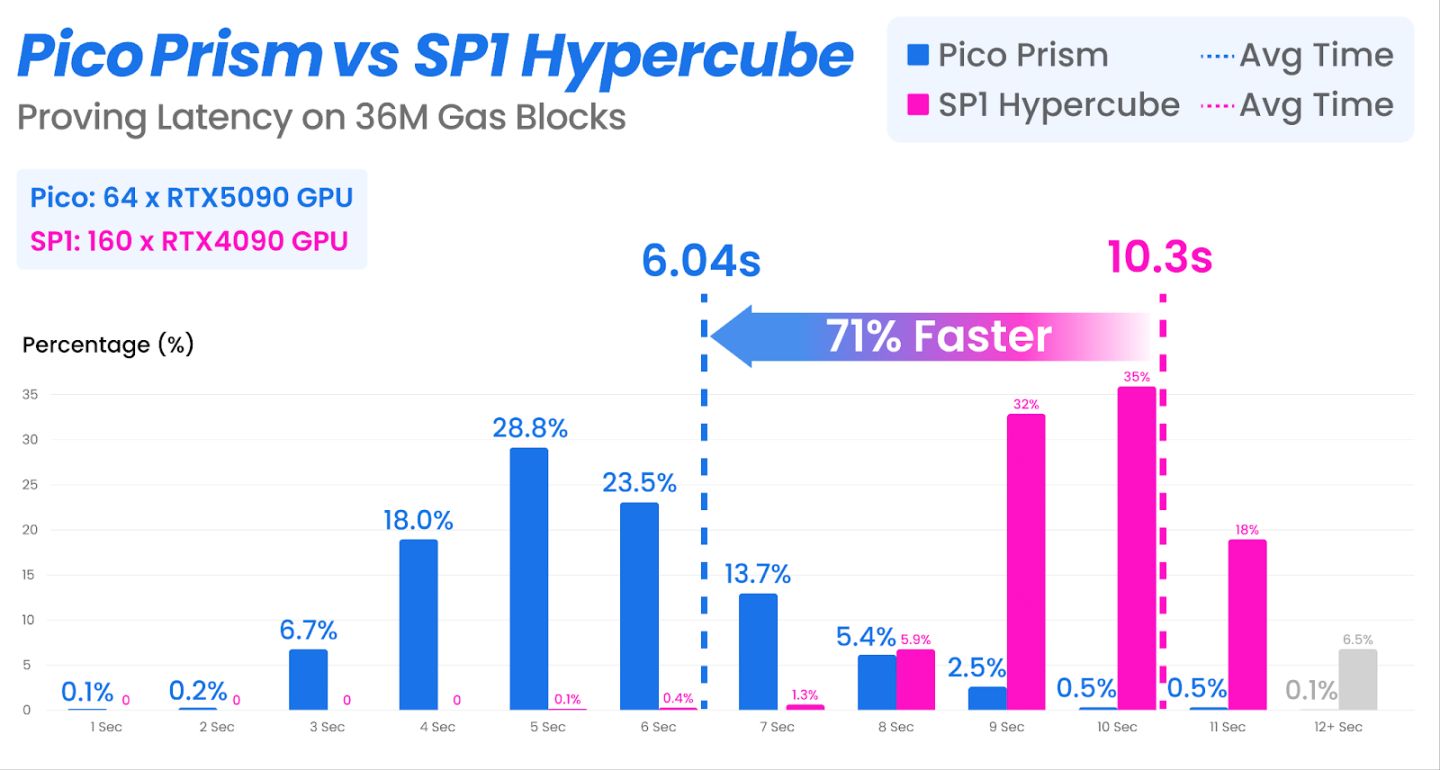The Ethereum community collectively gives a thumbs up: Has ZK technology finally moved from the lab to production-grade tools?
Brevis has achieved proof for 99.6% of Ethereum blocks within 12 seconds, with an average of just 6.9 seconds, using only 64 RTX 5090 GPUs.
Written by: 1912212.eth, Foresight News
Recently, discussions about Brevis have spread from technical forums to social media. The official Ethereum Twitter account, renowned Ethereum researcher Justin Drake, and even Vitalik have reposted and commented at length. What breakthrough has Brevis achieved to suddenly become the center of attention on the technical stage?

ZK Data Computation and Verification Platform
Brevis is a full-chain data computation and verification platform powered by ZK technology, enabling smart contracts to easily access and utilize multi-chain historical data as if reading an open encyclopedia.
To understand Brevis’s core value, we must start with Ethereum’s fundamental challenges. As the world’s largest smart contract platform, Ethereum has a massive amount of on-chain data. However, developers often face difficulties when building dApps: how to process this data efficiently and securely? Traditional methods either rely on centralized oracles (such as Chainlink), introducing trust risks, or perform computations directly on-chain, consuming enormous gas fees and limiting scalability.
Brevis fills this gap. Simply put, Brevis acts as an “intelligent assistant”: it performs complex computations off-chain and then generates zero-knowledge proofs, allowing on-chain contracts to verify the correctness of results. This design not only reduces costs but also ensures data integrity and availability.
Brevis’s tech stack is built on advanced ZK frameworks. It supports multiple blockchains, including Ethereum mainnet and its Layer 2 solutions, allowing users to read complete on-chain historical data—from transaction records to state changes. For example, a DeFi protocol can use Brevis to calculate users’ cross-chain credit scores without manually aggregating data; an NFT marketplace can verify the on-chain history of assets in real time, avoiding forgery risks.
Brevis is developed by Celer Network, founded by Dong Mo, who holds a Ph.D. from the University of Illinois at Urbana-Champaign. He is an expert in applying algorithmic game theory to protocol design and teaches full-stack smart contract courses. In November 2024, Brevis Network completed a $7.5 million seed round led by Polychain Capital and Binance Labs, with participation from IOSG Ventures, Nomad Capital, Bankless Ventures, Hashkey, and others.
ZK: From Lab Technology to “Production-Grade Tool”
The official Ethereum Twitter account reposted and gave high praise: “This is a big step toward Ethereum’s future. ZK technologies like Pico Prism will help Ethereum scale to meet global demand while maintaining its credibility and decentralization.”
Pico Prism is a distributed multi-GPU zkVM (zero-knowledge virtual machine) released by the Brevis team in October 2025. Essentially, it is an evolved version of Pico zkVM, optimized for real-time Ethereum block proofs.

In traditional ZK systems, generating proofs is often time-consuming and resource-intensive, requiring high-end hardware and several minutes of computation, which limits real-time applications. Pico Prism breaks this bottleneck: it achieves proof for 99.6% of Ethereum blocks within 12 seconds, with an average of just 6.9 seconds, using only 64 RTX 5090 GPUs.
Succinct’s SP1 Hypercube solution achieved a 40.9% real-time proof coverage (latency less than 10 seconds) on blocks with a 36 million gas limit, using 160 GPUs and a hardware capital expenditure of about $256,000. Compared to competitors like SP1, Pico Prism is 32 times faster and reduces GPU hardware costs by 50%.

This efficiency is due to its modular architecture: Pico Prism decomposes the proof process into parallel tasks, leveraging multi-GPU collaboration and avoiding single-machine bottlenecks.
Pico Prism’s advantage also lies in expanding real-world application scenarios. It shifts Ethereum’s verification model from “re-execution” to “one-time verification,” theoretically increasing network capacity by 100 times. Imagine a real-time DeFi lending scenario: a user submits a transaction, Pico Prism instantly generates a ZK proof to confirm the borrower’s on-chain credit history, without requiring full nodes to recalculate. This not only reduces gas fees but also enhances security—the proof process is fully zero-knowledge, protecting user privacy.
Previously, each validator needed to re-execute every transaction to verify blocks. This required expensive hardware and created a fundamental bottleneck: the more transactions, the greater the workload for each validator. Real-time proofs break this model. One prover generates a proof, and everyone else can verify it within milliseconds. Pico Prism has already demonstrated its technical feasibility at production scale.
Another highlight of Pico Prism is its compatibility: it supports custom computations, allowing users to adjust proof logic according to dApp needs, rather than being limited to fixed templates. This makes it highly valuable for Layer 2 Rollups or cross-chain bridges, such as helping Optimism or Arbitrum verify mainnet data in real time and reducing latency risks.
Through Pico Prism, Brevis not only solves the pain point of proof speed but also lowers the entry barrier: previously, hundreds of GPUs were required, but now consumer-grade hardware is sufficient. This is great news for small and medium developers, who can easily integrate Brevis to build smarter dApps. Pico Prism’s parallel optimization and cost reduction are turning ZK from a lab technology into a production-grade tool.
Of course, Brevis and Pico Prism are not perfect—there is still a 2.2% gap to achieving the goal of “real-time proofs within 10 seconds.” Official sources state that the next step for Pico Prism is to focus on reducing proof costs. The plan is to achieve 99% real-time proofs using fewer than 16 RTX 5090 GPUs in the coming months.
Points Airdrop
Currently, Brevis’s official Sparks points campaign is live. Sparks tokens will count toward eligibility for future TGE token airdrops. The more Sparks tokens you have, the larger your airdrop allocation. There is no upper limit to the number of Sparks tokens.
The first phase runs from October 13 to November 2, during which users must complete tasks such as check-ins, likes, reposts, and referrals. The second phase starts on November 3, requiring users to engage in real ecosystem interactions. Full details of the protocol and tasks will be announced at launch.
In addition, Twitter accounts must be at least 30 days old. Each wallet supports only one account, and points are updated every 5 minutes to 24 hours.